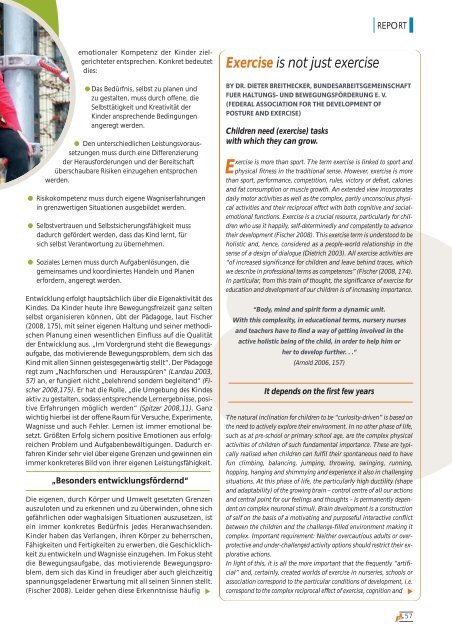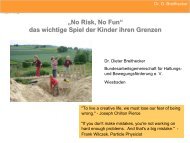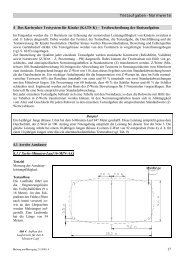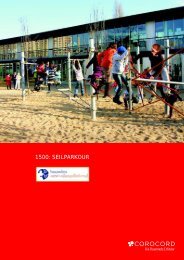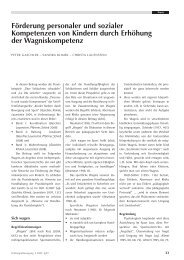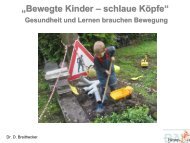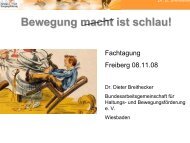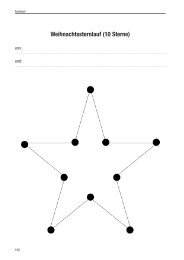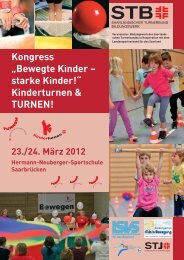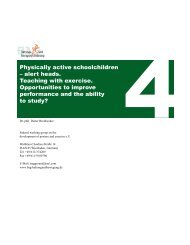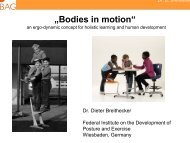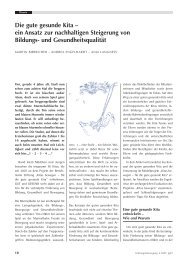Exercise is not just exercise - Bundesarbeitsgemeinschaft für Haltungs
Exercise is not just exercise - Bundesarbeitsgemeinschaft für Haltungs
Exercise is not just exercise - Bundesarbeitsgemeinschaft für Haltungs
Create successful ePaper yourself
Turn your PDF publications into a flip-book with our unique Google optimized e-Paper software.
emotionaler Kompetenz der Kinder zielgerichteter<br />
entsprechen. Konkret bedeutet<br />
dies:<br />
● Das Bedürfn<strong>is</strong>, selbst zu planen und<br />
zu gestalten, muss durch offene, die<br />
Selbsttätigkeit und Kreativität der<br />
Kinder ansprechende Bedingungen<br />
angeregt werden.<br />
● Den unterschiedlichen Le<strong>is</strong>tungsvoraussetzungen<br />
muss durch eine Differenzierung<br />
der Herausforderungen und der Bereitschaft<br />
überschaubare R<strong>is</strong>iken einzugehen entsprochen<br />
werden.<br />
● R<strong>is</strong>ikokompetenz muss durch eigene Wagn<strong>is</strong>erfahrungen<br />
in grenzwertigen Situationen ausgebildet werden.<br />
● Selbstvertrauen und Selbstsicherungsfähigkeit muss<br />
dadurch gefördert werden, dass das Kind lernt, <strong>für</strong><br />
sich selbst Verantwortung zu übernehmen.<br />
● Soziales Lernen muss durch Aufgabenlösungen, die<br />
gemeinsames und koordiniertes Handeln und Planen<br />
erfordern, angeregt werden.<br />
Entwicklung erfolgt hauptsächlich über die Eigenaktivität des<br />
Kindes. Da Kinder heute ihre Bewegungsfreizeit ganz selten<br />
selbst organ<strong>is</strong>ieren können, übt der Pädagoge, laut F<strong>is</strong>cher<br />
(2008, 175), mit seiner eigenen Haltung und seiner method<strong>is</strong>chen<br />
Planung einen wesentlichen Einfluss auf die Qualität<br />
der Entwicklung aus. „Im Vordergrund steht die Bewegungsaufgabe,<br />
das motivierende Bewegungsproblem, dem sich das<br />
Kind mit allen Sinnen ge<strong>is</strong>tesgegenwärtig stellt“. Der Pädagoge<br />
regt zum „Nachforschen und Herausspüren“ (Landau 2003,<br />
57) an, er fungiert nicht „belehrend sondern begleitend“ (F<strong>is</strong>cher<br />
2008,175). Er hat die Rolle, „die Umgebung des Kindes<br />
aktiv zu gestalten, sodass entsprechende Lernergebn<strong>is</strong>se, positive<br />
Erfahrungen möglich werden“ (Spitzer 2008,11). Ganz<br />
wichtig hierbei <strong>is</strong>t der offene Raum <strong>für</strong> Versuche, Experimente,<br />
Wagn<strong>is</strong>se und auch Fehler. Lernen <strong>is</strong>t immer emotional besetzt.<br />
Größten Erfolg sichern positive Emotionen aus erfolgreichen<br />
Problem und Aufgabenbewältigungen. Dadurch erfahren<br />
Kinder sehr viel über eigene Grenzen und gewinnen ein<br />
immer konkreteres Bild von ihrer eigenen Le<strong>is</strong>tungsfähigkeit.<br />
„Besonders entwicklungsfördernd“<br />
Die eigenen, durch Körper und Umwelt gesetzten Grenzen<br />
auszuloten und zu erkennen und zu überwinden, ohne sich<br />
gefährlichen oder waghalsigen Situationen auszusetzen, <strong>is</strong>t<br />
ein immer konkretes Bedürfn<strong>is</strong> jedes Heranwachsenden.<br />
Kinder haben das Verlangen, ihren Körper zu beherrschen,<br />
Fähigkeiten und Fertigkeiten zu erwerben, die Geschicklichkeit<br />
zu entwickeln und Wagn<strong>is</strong>se einzugehen. Im Fokus steht<br />
die Bewegungsaufgabe, das motivierende Bewegungsproblem,<br />
dem sich das Kind in freudiger aber auch gleichzeitig<br />
spannungsgeladener Erwartung mit all seinen Sinnen stellt.<br />
(F<strong>is</strong>cher 2008). Leider gehen diese Erkenntn<strong>is</strong>se häufig<br />
<strong>Exerc<strong>is</strong>e</strong> <strong>is</strong> <strong>not</strong> <strong>just</strong> exerc<strong>is</strong>e<br />
REPORT<br />
BY DR. DIETER BREITHECKER, BUNDESARBEITSGEMEINSCHAFT<br />
FUER HALTUNGS- UND BEWEGUNGSFÖRDERUNG E. V.<br />
(FEDERAL ASSOCIATION FOR THE DEVELOPMENT OF<br />
POSTURE AND EXERCISE)<br />
Children need (exerc<strong>is</strong>e) tasks<br />
with which they can grow.<br />
<strong>Exerc<strong>is</strong>e</strong> <strong>is</strong> more than sport. The term exerc<strong>is</strong>e <strong>is</strong> linked to sport and<br />
physical fitness in the traditional sense. However, exerc<strong>is</strong>e <strong>is</strong> more<br />
than sport, performance, competition, rules, victory or defeat, calories<br />
and fat consumption or muscle growth. An extended view incorporates<br />
daily motor activities as well as the complex, partly unconscious physical<br />
activities and their reciprocal effect with both cognitive and socialemotional<br />
functions. <strong>Exerc<strong>is</strong>e</strong> <strong>is</strong> a crucial resource, particularly for children<br />
who use it happily, self-determinedly and competently to advance<br />
their development (F<strong>is</strong>cher 2008). Th<strong>is</strong> exerc<strong>is</strong>e term <strong>is</strong> understood to be<br />
hol<strong>is</strong>tic and, hence, considered as a people-world relationship in the<br />
sense of a design of dialogue (Dietrich 2003). All exerc<strong>is</strong>e activities are<br />
“of increased significance for children and leave behind traces, which<br />
we describe in professional terms as competences” (F<strong>is</strong>cher (2008, 174).<br />
In particular, from th<strong>is</strong> train of thought, the significance of exerc<strong>is</strong>e for<br />
education and development of our children <strong>is</strong> of increasing importance.<br />
“Body, mind and spirit form a dynamic unit.<br />
With th<strong>is</strong> complexity, in educational terms, nursery nurses<br />
and teachers have to find a way of getting involved in the<br />
active hol<strong>is</strong>tic being of the child, in order to help him or<br />
her to develop further. . .“<br />
(Arnold 2006, 157)<br />
It depends on the first few years<br />
The natural inclination for children to be “curiosity-driven” <strong>is</strong> based on<br />
the need to actively explore their environment. In no other phase of life,<br />
such as at pre-school or primary school age, are the complex physical<br />
activities of children of such fundamental importance. These are typically<br />
real<strong>is</strong>ed when children can fulfil their spontaneous need to have<br />
fun climbing, balancing, jumping, throwing, swinging, running,<br />
hopping, hanging and shimmying and experience it also in challenging<br />
situations. At th<strong>is</strong> phase of life, the particularly high ductility (shape<br />
and adaptability) of the growing brain – control centre of all our actions<br />
and central point for our feelings and thoughts – <strong>is</strong> permanently dependent<br />
on complex neuronal stimuli. Brain development <strong>is</strong> a construction<br />
of self on the bas<strong>is</strong> of a motivating and purposeful interactive conflict<br />
between the children and the challenge-filled environment making it<br />
complex. Important requirement: Neither overcautious adults or overprotective<br />
and under-challenged activity options should restrict their explorative<br />
actions.<br />
In light of th<strong>is</strong>, it <strong>is</strong> all the more important that the frequently “artificial”<br />
and, certainly, created worlds of exerc<strong>is</strong>e in nurseries, schools or<br />
association correspond to the particular conditions of development, i.e.<br />
correspond to the complex reciprocal effect of exerc<strong>is</strong>e, cognition and<br />
57
REPORT<br />
nicht konform dem<br />
Überangebot an Produkten<br />
und Konzepten<br />
zur Spiel- und Bewegungsförderung.<br />
Ein Großteil der Angebote<br />
suggeriert dem<br />
Verbraucher ein höchstes<br />
Maß an Wirksamkeit,<br />
ohne diesen Anspruch auch<br />
immer verlässlich einzuhalten. Kindergärten,<br />
Schulen, Elternhaus und Kommunen sind<br />
angesichts dieser unübersichtlichen Angebotspalette<br />
partiell überfordert, die aus ihrer pädagog<strong>is</strong>chen Verantwortung<br />
gebotene Entscheidung zu treffen. Darüber hinaus<br />
sind <strong>für</strong> den Kunden häufig keine objektiv nachvollziehbaren<br />
Qualitätskriterien sowie deren pädagog<strong>is</strong>che<br />
Wertigkeit erkennbar. Da Entscheidungen <strong>für</strong> wert- und<br />
nachhaltige Anschaffungen dem Verbraucher nicht immer<br />
leicht fallen, soll das neu geschaffene Qualitätssiegel eine<br />
Orientierungshilfe geben. Das Qualitätssiegel zeichnet Pro-<br />
social-emotional competence of children in a more purposeful way.<br />
In concrete terms th<strong>is</strong> means:<br />
● The need to plan and design by oneself must be stimulated by<br />
autonomous conditions which appeal to the self-activity and<br />
creativity of children.<br />
● The different performance requirements must be conformed to via<br />
a differentiation of challenges and the readiness to assume r<strong>is</strong>ks.<br />
● R<strong>is</strong>k competence must be developed via one’s own adventurous<br />
experiences in borderline situations.<br />
● Confidence and the ability to protect oneself have to be promoted<br />
so that the child learns to be able to take responsibility by h<strong>is</strong> or<br />
herself.<br />
● Social learning must be stimulated through task solutions and the<br />
required common, coordinated actions and plans.<br />
Development mainly takes place through the child’s own activity. As<br />
children of today are rarely able to organ<strong>is</strong>e their freedom of movement,<br />
the educational<strong>is</strong>t, according to F<strong>is</strong>cher (2008, 175), has an important<br />
influence on the quality of the development with th<strong>is</strong> own mindset and<br />
h<strong>is</strong> methodical planning. “In the foreground <strong>is</strong> the movement task, the<br />
motivating exerc<strong>is</strong>e problem, making the child alert with all senses”.<br />
The educational<strong>is</strong>t suggests “investigating and sensing” (Landau<br />
2003, 57), he claims <strong>not</strong> “educational but collateral” (F<strong>is</strong>cher 2008,<br />
175). It has the role of “actively creating the surroundings of the child<br />
so that corresponding learning outcomes and positive experiences become<br />
possible” (Spitzer 2008, 11). The open space for tests, experiments,<br />
adventures and also errors <strong>is</strong> also important. Learning <strong>is</strong> always<br />
an emotional <strong>is</strong>sue. Positive emotions from successfully coping with<br />
problems and tasks ensure great success. Thus, children experience a<br />
great deal through their own limits and always gain a concrete image<br />
of their own capabilities.<br />
58<br />
dukte, Initiativen und<br />
Konzepte (Innenraumund<br />
Freiraumkonzepte)<br />
aus, welche Kinder in ihrem<br />
grundlegenden Spiel-,<br />
Bewegungs- und Erkundungsdrang<br />
in vielfältigen,<br />
anregenden und herausfordernden<br />
Situationen nachhaltig<br />
unterstützen. Seit 2008 sind<br />
bereits mehrere Produkte / Initiativen<br />
/ Konzepte ausgezeichnet worden.<br />
(www.besondersentwicklungsfoerdernd.de)<br />
Der Seilparkour:<br />
Abenteuer <strong>für</strong> Kopf und Körper<br />
Zu den „besonders entwicklungsfördernden“ Produkten gehört<br />
auch der „Seilparkour“ der Firma Corocord aus Berlin.<br />
Die Idee des „Seilparkour“ basiert auf der aus Frankreich<br />
“Particularly development-supporting”<br />
Sounding out, recogn<strong>is</strong>ing and overcoming one’s own limits set by the<br />
environment and body, without exposing oneself to dangerous or hazardous<br />
situations, <strong>is</strong> always a concrete need for all adolescents. Children<br />
have the desire to control their body, to acquire skills and abilities,<br />
to develop dexterity and to assume r<strong>is</strong>ks. The focus <strong>is</strong> the movement<br />
task, the motivating movement problem, which the child faces<br />
in joyous - but at the same time - suspenseful expectation with all h<strong>is</strong><br />
or her senses. (F<strong>is</strong>cher 2008). Unfortunately these findings frequently<br />
do <strong>not</strong> conform to the surplus supply of products and concepts for promoting<br />
play and exerc<strong>is</strong>e. A good portion of the things offered suggests<br />
to the user a high degree of effectiveness without always reliably adhering<br />
to th<strong>is</strong> claim. Nurseries, schools, family homes and local authorities<br />
are, in light of th<strong>is</strong> confusing range of offers, partially overstrained<br />
when it comes to making dec<strong>is</strong>ions as part of their educational responsibilities.<br />
Furthermore, no objective, comprehensible quality criteria<br />
are <strong>not</strong>iceable for the customer, nor <strong>is</strong> the educational significance.<br />
As dec<strong>is</strong>ions relating to valuable and sustainable purchases are never<br />
easy for the user, the newly-created seal of quality should offer a ‘<br />
guideline’. The seal of quality d<strong>is</strong>tingu<strong>is</strong>hes products, initiatives and<br />
concepts (indoors and outdoors concepts) which fundamentally<br />
support children in their basic urges to play, exerc<strong>is</strong>e and explore<br />
in varied, stimulating and challenging situations. Several products<br />
/ initiatives / concepts have been awarded since 2008.<br />
(www.besondersentwicklungsfoerdernd.de)<br />
The rope parkour: Adventure<br />
for mind and body<br />
The “rope parkour” by the company Corocord, based<br />
in Berlin, <strong>is</strong> also one of the “particularly developmentpromoting”<br />
products. The idea of the “rope parkour” <strong>is</strong><br />
based on the urban trend sport “parkour” which derives<br />
from France. “Parkour” <strong>is</strong> an elegant mix of jumping,
REPORT<br />
running and somersaults, across all obstacles, which have to be<br />
tackled outdoors in public space. However, with Corocord, in place of<br />
the concrete walls and steel railings are innovative structures made<br />
out of 19mm-thick ropes and other elements such as membranes,<br />
wooden and aluminium sections. The “rope parkour” <strong>is</strong> made up of<br />
a total of nine elements. The individual elements are six metres long<br />
respectively and can be combined to make different landscapes of<br />
movement. Tackling the self-selected routes on the individual proficiency<br />
level, requires the use of the whole body. Using the musculature<br />
so powerfully and coordinated to master situations that can, to<br />
some extent, only be tackled with the hand grip and with the confined<br />
position of the feet, develops trust in the child’s own ability and<br />
has lasting results for the child’s hol<strong>is</strong>tic development.<br />
In the “rope parkour”, depending on the strategies for coping, the<br />
respective basic motor characters as well as psychological strengths<br />
such as courage, will power, confidence, the ability to protect oneself,<br />
concentration and determination as well as targeted, coordinated<br />
actions with others are required. Th<strong>is</strong> does <strong>not</strong> <strong>just</strong> require<br />
important psychological competences but also requires many other<br />
cognitive abilities such as<br />
● tackling complex needs – competence in solving problems<br />
● think and act foresighted – strategic competence<br />
● plan targeted, coordinated actions – planning competence<br />
“The absence of such meta-cognitive competences<br />
represents a r<strong>is</strong>k factor for cognitive development and it<br />
<strong>is</strong> <strong>not</strong> uncommon that they also represent an impact on<br />
academic learning processes”<br />
(F<strong>is</strong>cher 2008, 177)<br />
60<br />
Integral d<strong>is</strong>covery areas and areas of<br />
experience in the “rope parkour”<br />
Depending on the situation or task, the “Rope Parkour” permits<br />
multiple access possibilities or different interpretations for educational<strong>is</strong>ts<br />
and children. In the centre of many exerc<strong>is</strong>e actions <strong>is</strong> the<br />
struggle with balance with respect to physical and psychological<br />
strengths. When the “Rope Parkour” <strong>is</strong> tackled the search for balance<br />
<strong>is</strong> priority everywhere and <strong>is</strong> identified through apparent contradictions:<br />
Purposeful kinetics and playful actions, tension and<br />
relaxation, r<strong>is</strong>k and safety, egot<strong>is</strong>m and social referencing, positive<br />
and negative feelings.<br />
For the psycho-physical area, the feelings of sensation and<br />
the personal handling of borderline situations acquire a<br />
special meaning. Being exposed to motivating exerc<strong>is</strong>e<br />
problems within the “Rope Parkour” (hazard-r<strong>is</strong>ksituations)<br />
- with which you can lose control of your<br />
position if you slip-up or if you select the wrong movement<br />
action – includes experiencing variable<br />
emotional stress conditions such as uncertaintycertainty,<br />
joy-anxiety. Children learn to assess<br />
their possibilities and limits and how best to avoid<br />
hazardous and r<strong>is</strong>ky situations.<br />
The success in achieving difficult exerc<strong>is</strong>e movements<br />
appears motivating. The child looks for repetition<br />
and a new calculated r<strong>is</strong>k. If the self-select r<strong>is</strong>ks,<br />
preferably <strong>not</strong> influenced from outside, are<br />
overcome, the child gains self-confidence<br />
and the ability to protect h<strong>is</strong> or herself.<br />
The exaggerated safety needs of adults<br />
unnecessarily thwart the child’s spontaneous<br />
action and, thus, important development<br />
processes.<br />
A special quality of the social-communicative<br />
area <strong>is</strong> in the movement contest<br />
with the “rope parkour”, especially with<br />
targeted partner or group tasks. Whoever<br />
enters the “rope parkour” with others, will<br />
develop social behaviour such as joint responsibility,<br />
cooperation and intuition. Cooperation<br />
can be practiced: with leading and following, with<br />
helping and securing, with the creation of exerc<strong>is</strong>es<br />
in groups. Comforting your partner “in an encouraging<br />
way”, to tackle the cruxes of a route together, mutually pointing<br />
out alternative exerc<strong>is</strong>es or having fun after the success of a<br />
joint venture with tackling the route - are all character<strong>is</strong>tics of it.<br />
In addition, it can definitely also lead to d<strong>is</strong>cussions encompassing<br />
safety-related aspects as well as the exposure to hazards and r<strong>is</strong>ks. If<br />
there <strong>is</strong> success in creating a bas<strong>is</strong> for understanding in the common<br />
exchange of experiences and opinions, problems of interaction and<br />
factual problems can be better assessed, and relational and expert<br />
actions can be developed and can ass<strong>is</strong>t with comprehension.<br />
The “rope parkour” with its many motor and psycho-social challenges<br />
can also play its part in helping children and teenagers to cope<br />
with themselves and with the world around them.<br />
Literature with the editor /// Photos: D. Breithecker


